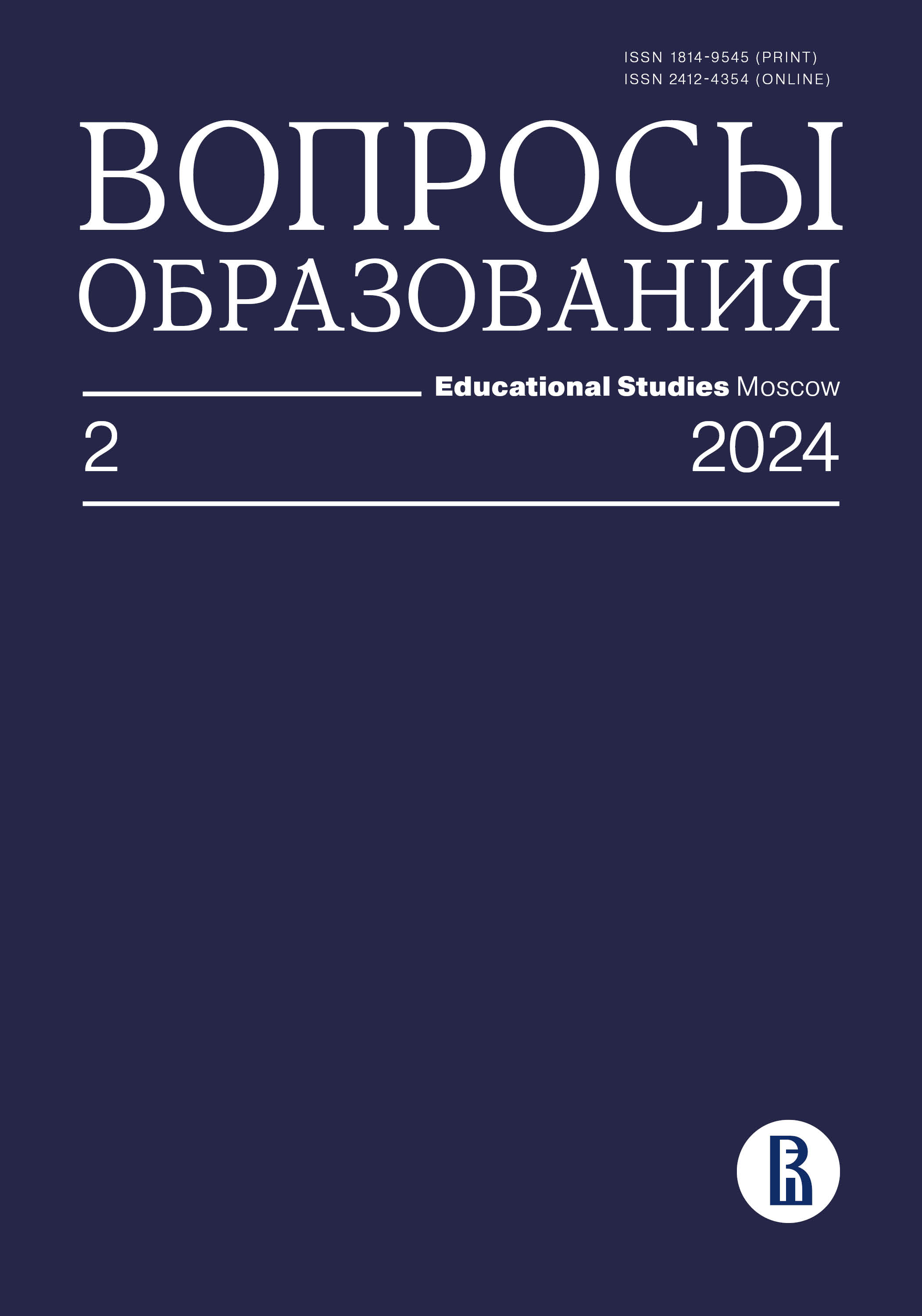Как измерять адапторский и инноваторский когнитивные стили: адаптация опросника М. Киртона для сферы образования
Аннотация
В статье описаны результаты создания русскоязычной версии и адаптации Kirton’s Adaptation-Innovation Inventory для измерения когнитивного стиля учителей и административных сотрудников школ. Предложен вариант перевода, который учитывает возникающие в русском языке коннотации и контекст образовательной сферы, но при этом эквивалентен по смыслу оригинальной шкале. Показано, что читаемость суждений соответствует уровню образования целевой аудитории измерения. В рамках итеративного процесса разработки и эмпирической проверки психометрических свойств опросника (N1 = 137, N2 = 1236, N3 = 204) достигнуты удовлетворительные показатели функционирования трех шкал, отдельных суждений и ответных категорий. Анализ производился в рамках классической теории тестирования и IRT-RSM-модели. Итоговый опросник «Адаптор — инноватор» включает 26 суждений и позволяет оценить выраженность трех факторов: «оригинальность и независимость», «доскональность и самоорганизованность», «инертность и запрос на инструкции». Предлагаемый опросник может быть использован в исследовательских и практических целях для изучения когнитивных стилей учителей и администрации школ, а также близких им групп, включая работников других уровней образования и социальной сферы в целом. В статье приведены полная версия опросника и практические рекомендации по работе с инноваторами и адапторами внутри образовательной организации.
Скачивания
Литература
Alalouch C. (2021) Cognitive Styles, Gender, and Student Academic Performance in Engineering Education. Education Sciences, vol. 11, no 9, Article no 502. https://doi.org/10.3390/educsci11090502
Al-Ghazali B.M. (2021) Understanding Employees’ Innovative Work Behavior through Interactionist Perspective: The Effects of Working Style, Supportive Noncontrolling Supervision and Job Complexity. European Journal of Innovation Management, vol. 26, no 1, pp. 230–255. https://doi.org/10.1108/EJIM-03-2021-0165
Andrich D. (1978) A Rating Formulation for Ordered Response Categories. Psychometrika, vol. 43, December, pp. 561–573. https://doi.org/10.1007/BF02293814
Andersen E.B. (1997) The Rating Scale Model. Handbook of Modern Item Response Theory (eds W.J. Linden, R.K. Hambleton), New York, NY: Springer, pp. 67–84. https://doi.org/10.1007/978-1-4757-2691-6_4
Bagozzi R.P., Foxall G.R. (1996) Construct Validation of a Measure of Adaptive-Innovative Cognitive Styles in Consumption. International Journal of Research in Marketing, vol. 13, no 3, pp. 201–213. https://doi:10.1016/0167-8116(96)00010-9
Bobic M., Davis E., Cunningham R. (1999) The Kirton Adaptation-Innovation Inventory. Review of Public Personnel Administration, vol. 19, no 2, pp. 18–31. https://doi.org/10.1177/0734371X9901900204
Cahill A.M. (2011) Use of Teams to Accomplish Radical Organization Change: Examining the Influence of Team Cognitive Style and Leader Emotional Intelligence (PhD Thesis). New York: Columbia University. https://doi.org/10.7916/D8P2752J
Cantos P., Almela Á. (2019) Readability Indices for the Assessment of Textbooks: A Feasibility Study in the Context of EFL. Vigo International Journal of Applied Linguistics. https://doi:10.35869/vial.v0i16.92
Chan D. (2010) Detection of Differential Item Functioning on the Kirton Adaption-Innovation Inventory Using Multiple-Group Mean and Covariance Structure Analyses. Multivariate Behavioral Research, vol. 35, no 2, pp. 169–199, https://doi.org/10.1207/S15327906MBR3502_2
Clapp R., de Ciantis S., Ruckthum V., Cornelius N. (2010) The Use of the Kirton Adaption-Innovation Inventory in Thailand: An Exploratory Study. AU-GSB e-Journal, vol. 3, no 2, pp. 3–24.
Clapp R.G., Rucktum V. (2017) The Cross-Cultural Use of the Kirton Adaption-Innovation Inventory: A Further Exploration. ABAC ODI Journal. Vision. Action. Outcome, vol. 4, no 2, Article no 104.
Coleman M., Liau T.L. (1975) A Computer Readability Formula Designed for Machine Scoring, Journal of Applied Psychology, vol. 60, no 2, pp. 283–284. https://doi.org/10.1037/h0076540
Crowne D.P., Marlowe D. (1964) The Approval Motive: Studies in Evaluative Dependence. New York, NY: Wiley.
Deprez J., Cools E., Robijn W., Euwema M. (2021) Choice for an Entrepreneurial Career: Do Cognitive Styles Matter? Entrepreneurship Research Journal, vol. 11, no 1, Article no 20190003. https://doi.org/10.1515/erj-2019-0003
Efimova G.Z. (2015) Male and Female Teachers: Similarities and Differences in the Sociological Portraits. Naukovedenie, vol. 7, no 5. http://dx.doi.org/10.15862/137PVN515
Ettlie J., O'Keefe R. (2007) Innovative Attitudes, Values, and Intentions in Organizations. Journal of Management Studies, vol. 19, no 2, pp. 163–182. https://doi.org/10.1111/j.1467-6486.1982.tb00066.x
Foxall G.R., Hackett P.M.W. (1994) Styles of Managerial Creativity: A Comparison of Adaption-Innovation in the United Kingdom, Australia and the United States. British Journal of Management, vol. 5, no 2, pp. 85–100. https://doi.org/10.1111/j.1467-8551.1994.tb00070.x
Fullan M. (2018) Surreal Change. The Real Life of Transforming Public Education. New York, NY: Routledge. http://dx.doi.org/10.4324/9781315682952
Goldsmith R., Matherly T.A. (1986) The Kirton Adaption Innovation Inventory, Faking, and Social Desirability: A Replication and Extension. Psychological Reports, vol. 58, no 1, pp. 269–270. https://doi.org/10.2466/pr0.1986.58.1.269
Gregoire J. (2018) ITC Guidelines for Translating and Adapting Tests. International Journal of Testing, vol. 18, no 2, pp. 101–134. https://doi.org/10.1080/15305058.2017.1398166
Hamby T., Peterson R.A. (2016) A Meta-Analytic Investigation of the Relationship between Scale-Item Length, Label Format, and Reliability. Methodology: European Journal of Research Methods for the Behavioral and Social Sciences, no 12, pp. 89–96. https://doi.org/10.1027/1614-2241/a000112
Johnson K.L., Danis W.M., Dollinger M.J. (2008) Are You an Innovator or Adaptor? The Impact of Cognitive Propensity on Venture Expectations and Outcomes. New England Journal of Entrepreneurship, vol. 11, no 2, pp. 29-45. https://doi.org/10.1108/NEJE-11-02-2008-B003
Im S., Hu M.Y. (2005) Revisiting the Factor Structure of the Kirton Adaption-Innovation Inventory. Psychological Reports, vol. 96, no 2, pp. 408–410E. https://doi.org/10.2466/pr0.96.2.408-410
Kapuza A., Tyumeneva Yu. (2016) Reliability and Dimensionality of the TALIS Scale of Social Desirability: Evidence from the Item Response Theory. Monitoring of Public Opinion: Economic and Social Changes, no 6, pp. 14–29 (In Russian). https://doi.org/10.14515/monitoring.2016.6.02
Kirton M.J. (1994) A Theory of Cognitive Style. Adaptors and Innovators: Styles of Problem Solving (ed. M.J. Kirton), London: Routledge, pp. 1–33.
Kirton M.J. (1980) Adaptors and Innovators in Organizations. Human Relations, vol. 33, no 4, pp. 213–224. https://doi.org/10.1177/001872678003300401
Kirton M.J. (1976) Adaptors and Innovators: A Description and Measure. Journal of Applied Psychology, vol. 61, no 5, pp. 622–629. https://doi.org/10.1037//0021-9010.61.5.622
Kirton M.J., Pender S. (1982) The Adaption-Innovation Continuum, Occupational Type, and Course Selection. Psychological Reports, vol. 51, no 3, pp. 883–886. https://doi.org/10.2466/pr0.1982.51.3.883
Kubes M. (1989) The Kirton Adaption-Innovation Inventory in Czechoslovakia. Proceedings of International Conference "Psychology of Creative Scientific Work" (Slovak Academy of Sciences, Bratislava, Czechoslovakia), pp. 151–167.
Lapushinskaya G.K. (2014) Grants for Schools: Features and Opportunities. Narodnoe obrazovanie, no 4, pp. 111–117 (In Russian).
Linacre J.M. (2002) Optimizing Rating Scale Category Effectiveness. Journal of Applied Measurement, vol. 3, no 1, pp. 85–106.
McKenna F.P. (1984) Measures of Field Dependence: Cognitive Style or Cognitive Ability? Journal of Personality and Social Psychology, vol. 47, no 3, pp. 593–603. https://doi.org/10.1037/0022-3514.47.3.593
Merton R.K. (1968) Social Theory and Social Structure. New York, NY: Free Press.
Messick F.P. (1984) The Nature of Cognitive Styles: Problems and Promise in Educational Practice. Educational Psychologist, vol. 19, no 2, pp. 59–74. https://doi.org/10.1080/00461528409529283
Mojavezi A., Tamiz M.P. (2012) The Impact of Teacher Self-Efficacy on the Students’ Motivation and Achievement. Theory and Practice in Language Studies, vol. 2, no 3, pp. 483–491. https://doi.org/10.4304/tpls.2.3.483-491
Oborneva I.V. (2005) Automation of Text Perception Quality Assessment. MCU Journal of Informatics and Informatization of Education, vol. 2, no 5, pp. 221–233 (In Russian).
Opekina T.P. (2022) Relationship of the Generalized Type of Partner Affection and the Functionality of Close Relationships. Proceedings of the VI International Scientific Conference "Psychology of Stress and Coping Behavior: Stability and Variability of Relationships, Personalities, Groups in an Era of Uncertainty" (Kostroma, 2022, September, 22–24), pp. 326–330 (In Russian).
Othman A., Hamzah M., Hashim N. (2014) Conceptualizing the Islamic Personality Model. Procedia—Social and Behavioral Sciences, vol. 130, May, pp. 114–119. https://doi.org/10.1016/j.sbspro.2014.04.014
Panova N.V. (2010) Occupational Strain and the Ways of Its Correction in the Personal and Professional Development of a Teacher. Vestnik of the M.K. Ammosov North-Eastern Federal University, no 2, pp. 113–120 (In Russian).
Paulhus D.L. (2002) Socially Desirable Responding: The Evolution of a Construct. The Role of Constructs in Psychological and Educational Measurement (eds H.I. Braun, D.N. Jackson, D.E. Wiley), New York, NY: Routledge, pp. 49–69. https://doi.org/10.4324/9781410607454
Pološki Vokić N., Aleksić A. (2020) Are Active Teaching Methods Suitable for All Generation Y students?—Creativity as a Needed Ingredient and the Role of Learning Style. Education Sciences, vol. 10, no 4, Article no 87. https://doi.org/10.3390/educsci10040087
Prato Previde G. (1991) Italian Adaptors and Innovators: Is Cognitive Style Underlying Culture? Personality and Individual Differences, vol. 12, no 1, pp. l–10. https://doi.org/10.1016/0191-8869(91)90125-U
Prato Previde G., Massimini F. (1984) Adattatori-Innovatori: Una Teoria ed una Misura della Creativitá nelle Organizzazioni [Adaptors and Innovators: A Description and a Measure of Creativity in Organizations]. Ricerche di Psicologia, no 3, pp. 99–134.
Prato Previde G., Rotondi P. (1996) Leading and Managing Change through Adaptors and Innovators. Journal of Leadership Studies, vol. 3, no 3, pp. 120–134. https://doi.org/10.1177/107179199700300312
Preston C.C., Colman A.M. (2000) Optimal Number of Response Categories in Rating Scales: Reliability, Validity, Discriminating Power, and Respondent Preferences. Acta Psychologia, vol. 104, iss. 1, pp. 1–15. https://doi.org/10.1016/S0001-6918(99)00050-5
Prokhorova M.V., Teregulova A.D. (2014) Diagnostics of Adaptiove-Innovative Cognitive Style. Vestnik of Lobachevsky University of Nizhni Novgorod, no 2, pp. 400–406 (In Russian).
Rodosky R. (2021) School Improvement Grant: Analysis of Kentucky Cohort I Schools (PhD Thesis). Louisville: University of Louisville. https://doi.org/10.18297/etd/3633
Rogers C.R. (1959) Toward a Theory of Creativity. Creativity and Its Cultivation (ed. H.H. Anderson), New York, NY: Harper & Brothers, pp. 69–82.
Rubashkin D. (2014) A Collective Model of Advanced Teacher Training: An International Experience. Voprosy obrazovaniya / Educational Studies Moscow, no 1, pp. 110–133 (In Russian). https://doi.org/10.17323/1814-9545-2014-1-110-133
Savchenko T.N., Faustova A.G. (2016) Adaptation of M. Kernis – A. Paradise "The Contingent Self-Esteem Scale". Eksperimental'naâ psihologiya / Experimental Psychology, vol. 9, no 4, pp. 79–89 (In Russian). https://doi.org/10.17759/exppsy.2016090408
Sailer M., Murböck J., Fischer F. (2021) Digital Learning in Schools: What Does It Take beyond Digital Technology? Teaching and Teacher Education, vol. 103, July, Article no 103346. https://doi.org/10.1016/j.tate.2021.103346
Salgado J. (2005) Personality and Social Desirability in Organizational Settings: Practical Implications for Work and Organizational Psychology. Papeles Del Psicólogo, vol. 26, pp. 115–127.
Scott R., Robinson B. (1996) Managing Technological Change in Education—What Lessons Can We All Learn? Computers & Education, vol. 26, no 1, pp. 131–134. https://doi.org/10.1016/0360-1315(96)00007-3
Shalashova M.M., Shevchenko N.I. (2016) The Corporate Model of Advanced Training: Preparing School Teams of Teachers for the Implementation of the FSES of General Education. Bulletin of Moscow Region State University, Series: Pedagogics, no 2, pp. 190–199 (In Russian). https://doi.org/10.18384/2310-7219-2016-2-190-199
Skinner N.F., Hutchinson L., Lukenda A., Drake G., Boucher J. (2003) National Personality Characteristics: 11. Adaption-Innovation in Canadian, American, and British Samples. Psychologzcal Reports, vol. 92, no 2, pp. 1–22. https://doi.org/10.2466/pr0.2003.92.1.21
Stum J. (2009) Kirton’s Adaption-Innovation Theory: Managing Cognitive Styles in Times of Diversity and Change. Emerging Leadership Journeys, vol. 2, no 1, pp. 66–78.
Subotic M., Maric M., Mitrovic S., Mesko M. (2018) Differences between Adaptors and Innovators in the Context of Entrepreneurial Potential Dimensions. Kybernetes, vol. 47, no 7, pp. 1363–1377. https://doi.org/10.1108/K-05-2017-0183
Tobing G., Angelina V.E., Franceline D., Anwar M.Y., Suwartono C., Halim M. (2020) Construct Validity of the Indonesian Version of Kirton`s Adaptaion-Innovation Inventory. Jurnal Psikologi Ulayat, vol. 1, no 2, pp. 303–316. https://doi.org/10.24854/jpu19
Tullett A.D., Kirton M.J. (1995) Further Evidence for the Independence of Adaptive-Innovative (A-I) Cognitive Style from National Culture. Personality and Individual Differences, vol. 19, no 3, pp. 393–396. https://doi:10.1016/0191-8869(95)00077-j
Wakita T., Ueshima N., Noguchi H. (2012) Psychological Distance between Categories in the Likert Scale: Comparing Different Numbers of Options. Educational and Psychological Measurement, vol. 72, no 4, pp. 533–546. https://doi.org/10.1177/0013164411431162
Weber M. (1970) Essays in Sociology. London: Routledge & Kegan Paul.
Wilcox K.C., Lawson H.A. (2018) Teachers’ Agency, Efficacy, Engagement, and Emotional Resilience during Policy Innovation Implementation. Journal of Educational Change, vol. 19, no 2, pp. 181–204. https://doi.org/10.1007/s10833-017-9313-0
Xu Y., Tuttle B.M. (2012) Adaption-Innovation at Work: A New Measure of Problem-Solving Styles. Journal of Applied Management Accounting Research, vol. 10, no 1, pp. 17–34.
Zeer Ye.F., Korneeva N.A. (2006) Social Hypocrisy as a Professionally Conditioned Deformation of the Teacher. The Education and Science Journal, no 4, pp. 81–90.
Zhang L. (2006) Does Student–Teacher Thinking Style Match/Mismatch Matter in Students’ Achievement? Educational Psychology, vol. 26, no 3, pp. 395–409. https://doi.org/10.1080/01443410500341262








